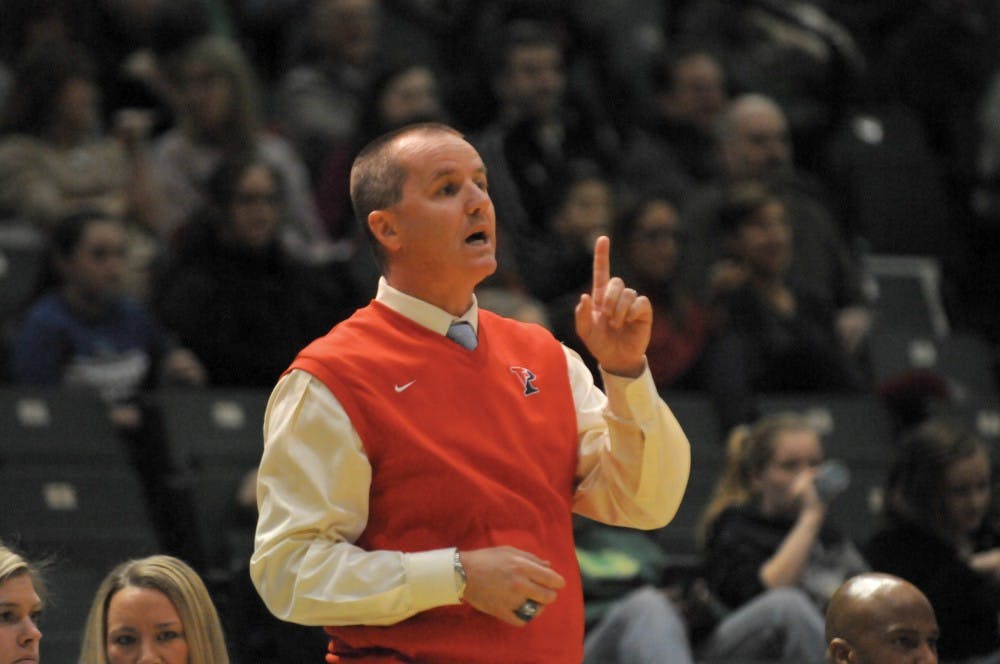If it seems like Penn women’s basketball is playing a slightly different game this year, that’s because they are.
At the start of the 2015-16 season, the NCAA transitioned from 20-minute halves in women’s basketball to 10-minute quarters. And since the start of Ivy play in early January, Penn coach Mike McLaughlin has focused on making play even shorter: relying on five-minute segments for his team’s strategic purposes.
“Quarters just become another stoppage for us,” he explained. “But we talk about it. We get to the first media timeout, and we just say, ‘We got outplayed that five minutes, let’s finish the last five minutes of the quarter. It’s a way to really keep on task a shorter amount of time. Keep them focused.”
McLaughlin’s strategy seems to be working. Since the Princeton game on Jan. 9, the Quakers have gone 7-1 and have outscored their opponents by an average of almost 15 points a game.
Still, although the transition to quarters may have seemed relatively seamless — the Quakers are 16-3 on the season, after all — there were bumps along the way.
“It took a little bit of getting used to,” senior guard Kasey Chamber said. “Anything does when it’s that drastic of a change. But I think we found a way to make it work for us in a very positive way and positive direction.”
Despite the early adjustments needed — especially for players like sophomore forward Michelle Nwokedi who went from quarters in high school to halves in college to quarters again in a three-year span — the Quakers were quick to notice some of the benefits to how they now have to approach gameplay.
“OK, so at first I was so against it — we were all really against the quarters — because we were just so used to playing the halves,” Nwokedi said. “But now that the quarters are here, the 10-minute quarters we divide up into five-minute segments. Coach always says, ‘If we’re playing one game, it’s eight, five-minute segments.’
“So it’s like, ‘Five minutes. OK. What can we do? What things can we do in five minutes?’ Then it’s the media timeout. Then it’s the next five minutes. Just keep focusing on those little, five-minute segments. So I actually like it better.”
When the NCAA announced the change in June 2015, McLaughlin brought his staff together to determine how they would approach the change.
There were a number of factors he felt that the staff needed to look at — particularly the effects on conditioning and of getting rid of the one-and-one after the seventh foul in favor a straight double-bonus after the fifth foul in a quarter. Nonetheless, he hasn’t seen much of an effect from the transition on his squad.
“I think we kind of fell right into it,” he said. “I don’t really see it changing who we are. I think that we were prepared for it. And I don’t think it’s changed the game a great deal.”
As the women are getting used to the new rules, a lot of attention is being paid to the effects. For his part, McLaughlin views this as a change that won’t just be limited to the women’s side of things, and that the men will adopt quarters as well before too long.
“From talking to other coaches, I think people like it,” he said. “And I wouldn’t be surprised to see the men start talking about the idea of 10-minute quarters.
“I think that’s what everyone plays growing up, I wouldn’t be surprised if it doesn’t find its way into the men’s game in the future here.”
At the end of the day, however, senior guard Kasey Chambers pointed out that, regardless of rule changes, the game itself is still the same.
“I definitely think [quarters make the game flow]. I liked the halves. I love the game of basketball, no matter what format it is in. But I think it was a good change.”









